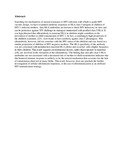| dc.contributor.author | Luscher, Mark A | |
| dc.contributor.author | Choy, Gregory | |
| dc.contributor.author | Embree, Joanne E | |
| dc.contributor.author | Nagelkerke, Nicolaas JD | |
| dc.contributor.author | Bwayo, JJ | |
| dc.contributor.author | Njenga, Simon | |
| dc.contributor.author | Plummer, FA | |
| dc.contributor.author | Barber, Brian H | |
| dc.contributor.author | Macdonald, Kelly S | |
| dc.date.accessioned | 2013-07-26T13:30:42Z | |
| dc.date.available | 2013-07-26T13:30:42Z | |
| dc.date.issued | 1998 | |
| dc.identifier.citation | AIDS Research and Human Retroviruses. January 20, 1998, 14(2): 99-107. | en |
| dc.identifier.issn | http://online.liebertpub.com/doi/abs/10.1089/aid.1998.14.99 | |
| dc.identifier.uri | http://erepository.uonbi.ac.ke:8080/xmlui/handle/123456789/51696 | |
| dc.identifier.uri | http://www.ncbi.nlm.nih.gov/pubmed/9462919 | |
| dc.description.abstract | Searching for mechanisms of natural resistance to HIV infection with which to guide HIV vaccine design, we have examined antibody responses to HLA class I antigens in children of HIV-1-infected mothers. Anti-HLA antibodies are known to block HIV infectivity in vitro and can be protective against SIV challenge in macaques immunized with purified class I HLA. It was hypothesized that alloantibody to maternal HLA in children might contribute to the prevention of mother-to-child transmission of HIV-1. In fact, a surprisingly high proportion of the children examined, 22%, were found to have antibody against class I alloantigens. This alloantibody, however, did not correlate with the HIV status of the children and was found in a similar proportion of children of HIV-negative mothers. The HLA specificity of the antibody was not correlated with noninherited maternal HLA alleles and occurred with a higher frequency in older children. This result suggests environmental factors, rather than exposure to maternal cells, are involved in the formation of the alloantibody. The finding that anti-allo-class I HLA antibodies are not associated with a decreased risk of mother-to-child transmission indicates that this humoral immune response is unlikely to be the natural mechanism that accounts for the lack of transmission observed in many births. This result, however, does not preclude the further investigation of cellular alloimmune responses, or the use of alloimmunization as an artificial HIV immunization strategy | en |
| dc.language.iso | en | en |
| dc.title | Anti-HLA Alloantibody Is Found in Children But Does Not Correlate with a Lack of HIV Type 1 Transmission from Infected Mothers | en |
| dc.type | Article | en |
| local.publisher | Department of Immunology, University of Toronto, Toronto, Canada M5S 1A8. | en |
| local.publisher | The Toronto Hospital, Toronto, Canada M5G 1X5. | en |
| local.publisher | Department of Medical Microbiology, University of Nairobi, Nairobi, Kenya. | en |
| local.publisher | Department of Medical Microbiology, University of Manitoba, Winnipeg, Canada R3T 2N2. | en |
| local.publisher | Department of Medicine, University of Toronto, Toronto, Canada M5S 1A8. | en |
| local.publisher | Mount Sinai Hospital, Toronto, Canada M5G 1X5. | en |

